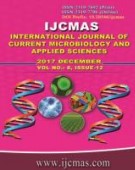


 National Academy of Agricultural Sciences (NAAS)
National Academy of Agricultural Sciences (NAAS)

|
PRINT ISSN : 2319-7692
Online ISSN : 2319-7706 Issues : 12 per year Publisher : Excellent Publishers Email : editorijcmas@gmail.com / submit@ijcmas.com Editor-in-chief: Dr.M.Prakash Index Copernicus ICV 2018: 95.39 NAAS RATING 2020: 5.38 |
Antioxidant and antimicrobial compounds in food play an important role in protecting health. These are also widely used as additives in fat, oils and in food processing to prevent or delay spoilage of foods. Attention towards the utilization of spices and some herbs as source of effective antioxidant and antimicrobial compounds has increased. In this study, the antioxidant and antibacterial properties of rosemary and oregano extracts were compared with synthetic antioxidant like butylated hydroxyl toluene (BHT). Antioxidant properties of DPPH radical scavenging, ferric reducing power assay and metal chelating activity were assessed at different concentrations 100ppm to 500ppm (p<0.05). DPPH radical scavenging activity of Rosemary and Oregano extracts were 77.37% and 62.86% at 100ppm respectively. Rosemary extract has shown highest ferric reducing activity at 500 µg /mL, which is almost equivalent to BHT at 200 mg/L. Although both rosemary and oregano extracts were less efficient in metal chelating activity compared to synthetic metal chelator (EDTA), rosemary extract exhibited more chelating activity compared to oregano extract. Antibacterial properties of rosemary and oregano extracts were assessed using the disc diffusion assay based on mean diameter of inhibitory zone and minimum inhibitory dose. Rosemary and oregano extracts were potentially active against gram+ve bacteria viz., Staphylococcus aureus and Bacillus subtilis whereas, smaller zones of inhibition against gram-ve bacteria viz., Escherichia coli, Salmonella typhium and Pseudomonas fluorescens. Therefore, among these two extracts, rosemary extract shown better antioxidant and antimicrobial properties compared to the oregano extract suggesting its application in food industry.
 |
 |
 |
 |
 |